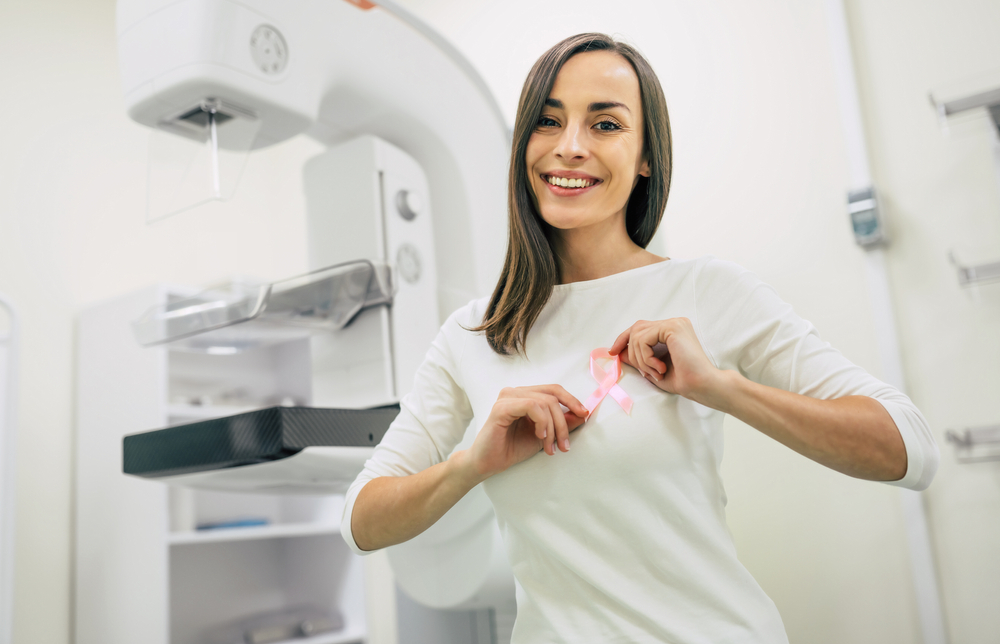- Breast cancer screening is important for all women over 45.
- Even those with no family history of breast cancer should have regular mammograms.
- The levels of radiation exposure caused by mammograms are minimal.
- Regular self-examination can provide an early warning for signs of the disease.
Breast cancer is one of the biggest health risks for women in the United States. It’s estimated that in 2022, 43,250 women will lose their lives to the disease, which makes breast cancer one of the nation’s leading causes of death for women.
One of the most impactful ways to lower breast cancer mortality is early diagnosis. By finding it as early as possible, breast cancer can be treated and any potential damage can be mitigated. The average risk of an American woman developing breast cancer during her lifetime is 13-percent, which means that screening done during regular health checkups can save many lives.
Recommended Age
The recommended age for annual mammograms depends on your individual risk levels. The American Cancer Society used to recommend that all women over the age of 40 have an annual mammogram. They’ve since updated that recommendation. Today, they recommend annual mammograms for women aged 45 to 54, with mammograms every other year for those aged 55 and over.
Women aged 40 to 44 can still request mammograms if they wish to have them; however, they’re only considered necessary for those who are at an increased risk of breast cancer. Someone may be considered ‘at risk’ if there’s a family history of the condition or they have the BRCA gene or another mutation that increases cancer risk.
No Significant Radiation Exposure
One common misconception is that mammograms expose people to high levels of radiation. Mammograms are a screening tool, which means they’re regulated by the Food and Drug Administration. As long as a woman has a mammogram at a venue that is approved by the FDA, the levels of radiation they’ll be exposed to should be minimal.
Background radiation is something we are exposed to every day of our lives, and the radiation exposure from a mammogram is only equivalent to about two months of background radiation. Given how important it is to diagnose breast cancer early, this level of exposure is considered worthwhile by medical professionals.
Kinds of Mammograms
Today, there are different mammogram options to choose from. The older, 2D style of mammogram takes a picture of each breast from the front and the side. In contrast, 3D mammograms take pictures from multiple angles so that they can create a more detailed picture of the breast. One benefit of this is that a 3D mammogram can more accurately identify small growths or anomalies.
The American Cancer Society notes that 2D mammograms are still a good diagnostic tool, and women should not worry about having a substandard scan if they’re offered a 2D mammogram. If a technician sees something on a 2D scan that could be cause for concern, the patient will be called back for further testing. The training of the person reading the mammogram is more important, in some ways, than the type of machine used.
Self-Examine Yourself Regularly
Women of all ages are advised to perform self-checks on their breasts once a month. It’s a good idea to do these tests on a regular schedule and at around the same time as your menstrual cycle if you have one. This will help you to become familiar with what they feel like, giving you a baseline. Performing a simple five-step check involving looking at the breasts and feeling for lumps could help identify breast cancer while it’s still in its early stages.
Make breast examinations a part of your regular routine when you bathe or take a shower, and you’ll get to know what your breast tissue looks like and feels like when it’s healthy. This makes it easier for you to identify changes that could be an early warning sign for disease.
Common Warning Signs
There are several early warning signs that women should look out for, including:
Lumps
One of the first warning signs of breast cancer is a lump. That said, not all lumps are a sign of breast cancer. Many women have lumps in their breast tissue that are benign. However, if you are performing a breast self-check and notice a lump that was not there before, seek medical advice as soon as possible. Even if you’re under the age of 40, it’s worth getting a mammogram to confirm the cause of a new lump in your breasts.
Changes in Size
Some women have one breast that is larger than the other, and this is not a cause for concern. However, if you notice that one of your breasts has changed in size suddenly, then it’s worth scheduling a mammogram to have that checked by a professional.
The best way to identify any changes is to perform monthly inspections in front of a mirror. The Cleveland Clinic says start by removing your shirt and bra and standing in front of a mirror. Place your arms at your sides and observe your breast shape and size.
Changes to Your Nipples
Any unusual changes to the nipples, such as discoloration, inversion, or unexplained discharge, should be checked by a doctor. If your nipples burn or become itchy or if you develop sores you should also have that checked by a doctor.
It’s also unusual for women to experience discharge from the nipples unless they’re lactating. Discharge from a woman who is not lactating may be a sign of breast cancer. This includes discharge that is clear, bloody, or any other color. Talk to your doctor if you develop any changes to your nipples.
Swelling or Dimpling
Swelling or dimpling of the breast or a warm sensation of inflammation could be a sign of breast cancer. You should also be on the lookout for dimpled skin, similar to the texture of an orange peel. Seek medical advice as soon as you notice this symptom.
Swelling of the breast isn’t the only symptom you need to look for. If you notice any swelling in your armpit or swelling near your collarbone, this could also indicate breast cancer. When this occurs, it typically means the breast cancer has spread to the lymph nodes, explains WebMD.
Pain
Some women experience breast tenderness at certain times of their menstrual cycle. There are many other reasons that a woman might experience breast tenderness, including menopause and perimenopause. However, painful breasts can also be a sign of breast cancer.
Pain caused by breast cancer can be felt in the nipple area or in any area of the breast. It’s important to seek advice from a medical professional and schedule a mammogram if you experience pain that feels different from your normal cycle, lasts longer, or comes on at an unexpected time of the month.
 fizkes / Shutterstock
fizkes / ShutterstockDo I Need a Referral for a Mammogram?
Many doctors will explicitly invite women for a mammogram every year, especially for women who are 45 to 54-years old. However, a referral is not a requirement.
Even if your doctor doesn’t send a referral, you can request a mammogram if you’re over the age of 40. If you’re under the age of 40 and are worried about the health of your breasts after performing a self-examination, or you have noticed any of the symptoms listed above, talk to your doctor and request a screening.
Early Diagnosis Can Save Lives
Early diagnosis of breast cancer can save lives. The average 5-year survival rate for women with nonmetastatic invasive breast cancer (cancer that has not spread to other parts of the body) is 90-percent. The average 10-year survival rate is 84-percent. Survival rates vary depending on where the cancer is located, but if the cancer is located only in the breast, then the survival rate can be as high as 99-percent.
This is why it’s important to catch breast cancer quickly. The condition is relatively easy to treat, and outcomes are usually good for those who receive early treatment. Many people have lost someone they love to cancer or know someone who is currently going through treatment, and this may cause some to fear the diagnosis. However, if that fear causes a person to avoid seeking medical advice, it could put their life at risk.
Don’t Ignore Warning Signs
Today, medical professionals have many options for treating breast cancer through surgery, chemotherapy, hormone therapies, and drugs. The sooner the cancer is identified, the more treatment options will be available and the more likely it is that those treatments will be a success.
For this reason, it’s important that you don’t ignore the warning signs and instead, get screened. Being diligent with self-examinations can help detect breast cancer early. Be on the lookout for changes and always voice your concerns to your doctor.














